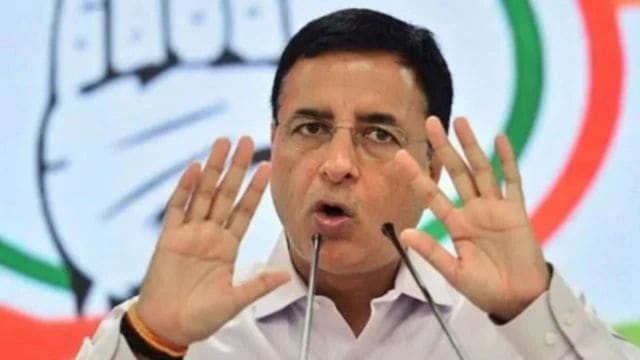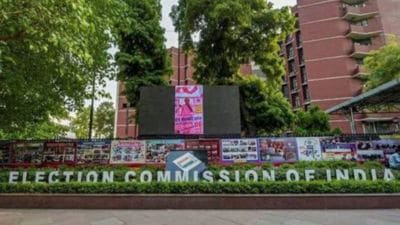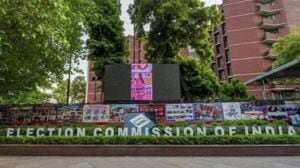Rise in collector rates | Congress says common man’s dream of owning a house ‘shattered’, BJP retorts: ‘claims baseless’
Addressing the media on Sunday, Congress MP Randeep Singh Surjewala said: “According to an estimate, the increase in collector rate will put a burden of Rs 5,000 crore on the people of Haryana annually"
 Questioning the rationale behind this steep hike, Surjewala accused the government of burdening the common man to meet government’s own revenue targets and benefit private developers (File)
Questioning the rationale behind this steep hike, Surjewala accused the government of burdening the common man to meet government’s own revenue targets and benefit private developers (File)Claiming that the collector rates have been increased varying between 100 to 250 per cent in several districts across the state, the Congress has slammed the BJP government in Haryana, saying the steep hike will “shatter” the common man’s dream of owning a house.
The state government, however, refuted the Opposition’s claims, calling it “rumours”, “baseless”, and “devoid of any factual basis”. In a statement released on Sunday evening, the government said only 8.37 per cent areas across Haryana that fall in the category where “transaction value exceeds the collector rate by more than 200 per cent, a maximum of 50 per cent hike in collector rate has been implemented”.
Collector rates are the minimum value at which any property can be registered in the government records. These rates serve as the benchmark to estimate the registration fee and stamp duty that needs to be paid while buying a property.
The government’s spokesperson added that in 72.01 per cent areas across Haryana, where the transaction value falls within 0 to 35 per cent of the collector rate, a 10 per cent hike in collector rate has been implemented.
“Nowhere has the rate been increased by more than 50 per cent. In fact, in many areas, the revision has been limited to just 10 per cent or 15 per cent. Moreover, even after these adjustments, collector rates in most places remain significantly lower than the prevailing market rates,” the spokesperson said.
Addressing the media on Sunday, Congress MP Randeep Singh Surjewala said: “According to an estimate, the increase in collector rate will put a burden of Rs 5,000 crore on the people of Haryana annually… the steep hike in collector rates will shatter the common man’s dream of owning a house”.
“The hike has triggered widespread criticism and raises serious concerns about housing affordability, especially for the poor, middle class, and lower-income groups,” he added.
Questioning the rationale behind this steep hike, Surjewala accused the government of burdening the common man to meet government’s own revenue targets and benefit private developers.
“In 2022, the state government had promised a pucca house for every citizen. However, that dream now appears to be slipping away, as rising land valuation, inflated property prices, and increased stamp duty are making homeownership unaffordable for many. The average citizen, already struggling with EMIs, is now facing an additional burden due to inflated registration and documentation costs,” the Congress MP added.
Making further assertions, the Congress leader said, “The state budget for 2025–26 sets a revenue collection target of Rs 16,555 crore through stamp duty and registration fees — up from Rs 14,000 crore in 2024–2025. To bridge fiscal gaps, especially those created by declining revenues from excise and liquor taxes, the government has now chosen to increase the collector rates as a backdoor tax. The collector rate hike disproportionately affects the housing sector, triggering automatic price increases in flats, plots, and builder projects. This is especially evident in regions developed under the Deen Dayal Awas Yojana, where builders shall be passing on the cost to buyers. As a result, housing inflation will continue to rise, making even basic housing unaffordable for many”.
Drawing a comparison between 2018-19 and 2024-2025, Surjewala said, “Collector rates have been increased between 50 per cent and 250 per cent in cities like Gurugram, Faridabad, Panchkula, Ambala, Karnal, Rohtak, Rewari, and Sonipat. This massive jump has occurred even as basic civic infrastructure — roads, water supply, sewage — remains inadequate in many areas”.
Surjewala also raised 10 pointed questions seeking the chief minister’s reply, with the main ones being the absence of a clear, scientific framework for collector rate revisions, lack of mechanism to ensure affordable housing, and the alleged nexus between government and real estate developers.
The government, however, refuted Surjewala and other Opposition leaders’ claims. A government spokesperson said, “Revision of collector rates is a routine annual exercise carried out transparently and in alignment with prevailing market prices. This revision is guided by a data-driven and rational methodology, which analysis the top 50 per cent of property registrations in each segment specifically, where the transaction value exceeds the prevailing collector rate”.
The spokesperson added that the “government’s aim is to promote transparent transactions, effectively curb black money, and provide the public with the opportunity to buy and sell property at fair and real market values”.
What does the government claim?
— A total of 2,46,812 collector rate segments across Haryana have been revised, with increases applied according to their respective transaction value slots, government spokesperson said.
— 1,77,731 segments, accounting for 72.01 per cent of the total, fall within the 0 to 35 per cent transaction value slot, where a 10 per cent increase has been implemented.
— 19,966 segments (8.09 per cent) fall within the 35 to 70 per cent transactional value slot, where a 15 per cent increase has been applied.
— 10,985 segments (4.45 per cent) where the transaction value exceeds the collector rate by 70 to 100 per cent, a 20 per cent increase has been implemented.
— 11,078 segments (4.49 per cent) fall in the 100 to 150 per cent slot, where the increase is 30 per cent.
— 6,393 segments (2.59 per cent) fall in the 150 to 200 percent range, where a 40 per cent increase has been applied.
— 20,659 segments (accounting for 8.37 per cent of the total), fall in the category where the transaction value exceeds the collector rate by more than 200 per cent, a maximum increase of 50 per cent has been implemented.












